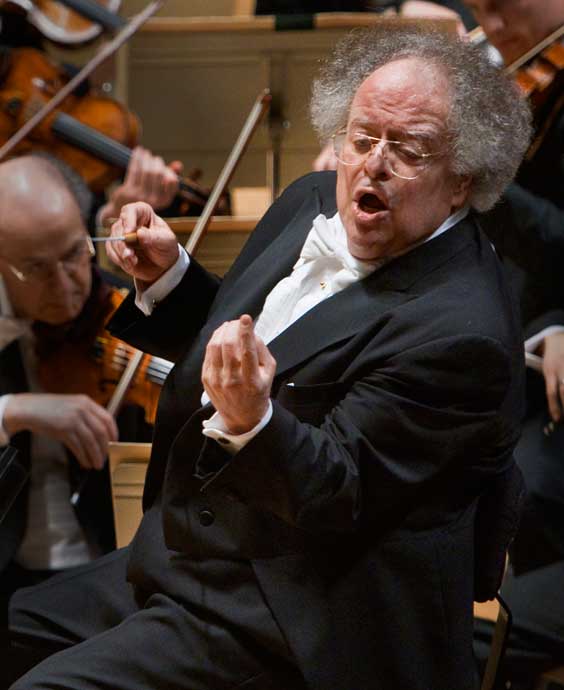Levine, MET Orchestra bring weight and precision to Carter and Beethoven
The most consequential thing about the MET Orchestra’s Sunday afternoon concert at Carnegie Hall turned out to be the least notable. Late in the week, soprano Elina Garanca, who would have sung Alban Berg’s Seven Early Songs, withdrew—illness prevented her from preparing the music. Into the void, at short notice, stepped Anna Netrebko.
Many surely saw that as a net gain. Netrebko is, after all, the reigning contemporary opera diva. However, she didn’t sing Berg’s songs either—no time to prepare—and instead tossed off Dvorak’s “Song to the Moon,” from Rusalka, and “Cäcilie,” the second of Strauss’ Op. 27 songs. Conductor James Levine and the orchestra knew the music as well as Netrebko, so the singing and playing were excellent, entertaining, and once the automatic ovation died down, evanescent.
What was disappointing about the program change was that Berg’s music is far more substantial that what was substituted, and his songs were part of a clear, overall aesthetic that Levine had devised. But even with that hole in the concert, the remaining music—Symphony No. 2 from both Beethoven and Schumann, and Elliott Carter’s Three Illusions—had such weight, and was played so well, that one left thinking how great an instrumental concert it was.
Weight, heft, substance, those were the common themes. Levine used a large orchestra for Beethoven’s symphony, and the big, full sound the orchestra produced, especially the strings, was a pleasure. There was no drag to the size of the sound, the playing was fleet throughout, all the details of the score were clear.
The first movement was thrilling, the lithe, muscular playing created an image of a classic hero striding the landscape, undaunted by any sturm und drang. Levine’s tempo for the Larghetto was an unsentimental Adante, and an emphasis on the contrast between legato and tenuto string playing produced an outsized expressive effect. The third movement had a superb feeling of the steps and ceremony of the dance, and even though it took the first four bars of the last movement for the orchestra to catch up to the conductor, the playing was full of energy and joy.
Three Illusions, which Levine premiered with the Boston Symphony in 2005, is a distillation of the brilliant, aphoristic style of Carter’s work from his ninth decade on. The three parts—“Micomicón,” “Fons Juventatis,” and “More’s Utopia”—total maybe ten minutes duration. Carter scores for a large orchestra yet writes with such spare precision that it almost sounds like chamber music. The polyphony is particularly unadorned, and the subject matter, the dangers of utopian thinking, was important to the composer in his last years.
What is most typical about the piece, and what is still both fascinating and disorienting about his late music, is how there is no repetition. Carter may use a sequence of notes, as in the brass fanfare that opens “Micomicón,” to establish and develop a longer phrase, but once fully completed that phrase, or any other gesture or rhythm, never reappears. That, and the quickness of his thinking, makes the experience of his work complex but never dense. The music vanishes quickly and leaves a mark in the mind one wants to follow, especially the details like the snare drum used to play expressive grace notes in the second movement, and the exceptionally imaginative and skillful percussion orchestration in “More’s Utopia.”
Orchestration is the key to received critical wisdom about Schumann’s symphonies. The consensus is that the composer handled that responsibility poorly, and that his music needs to be rescued by a skillful conductor. That’s complete nonsense. Schumann’s symphonies do need a skillful conductor, but his orchestrations are fine.
But Schumann can’t be played like Beethoven. Where Beethoven builds, Schumann sings, and a conductor needs to hear how the music sang to Schumann, and how the composer uses transitions to get from one lyrical section to another.
It was no surprise that Levine made Schumann sing, and ring. The Symphony No. 2 is a great work and an important way-station between Bach and Mahler. The music follows the obligations of the form but it wants to constantly discard them and keep spinning out more and more narrative, more and more lyricism, longer and longer lines. The contrast between the slow, rich polyphonic fanfare that begins the entire piece, and the explosive momentum that follows and barely rests through the four movements, was ideal, with Levine and the orchestra building a sense of tension and eager anticipation. It was a great, glorious sound.
James Levine leads the MET Chamber Ensemble in music by Stravinsky, Ives, Carter, Cage, and Wuorinen 5 p.m. March 8. carnegiehall.org
